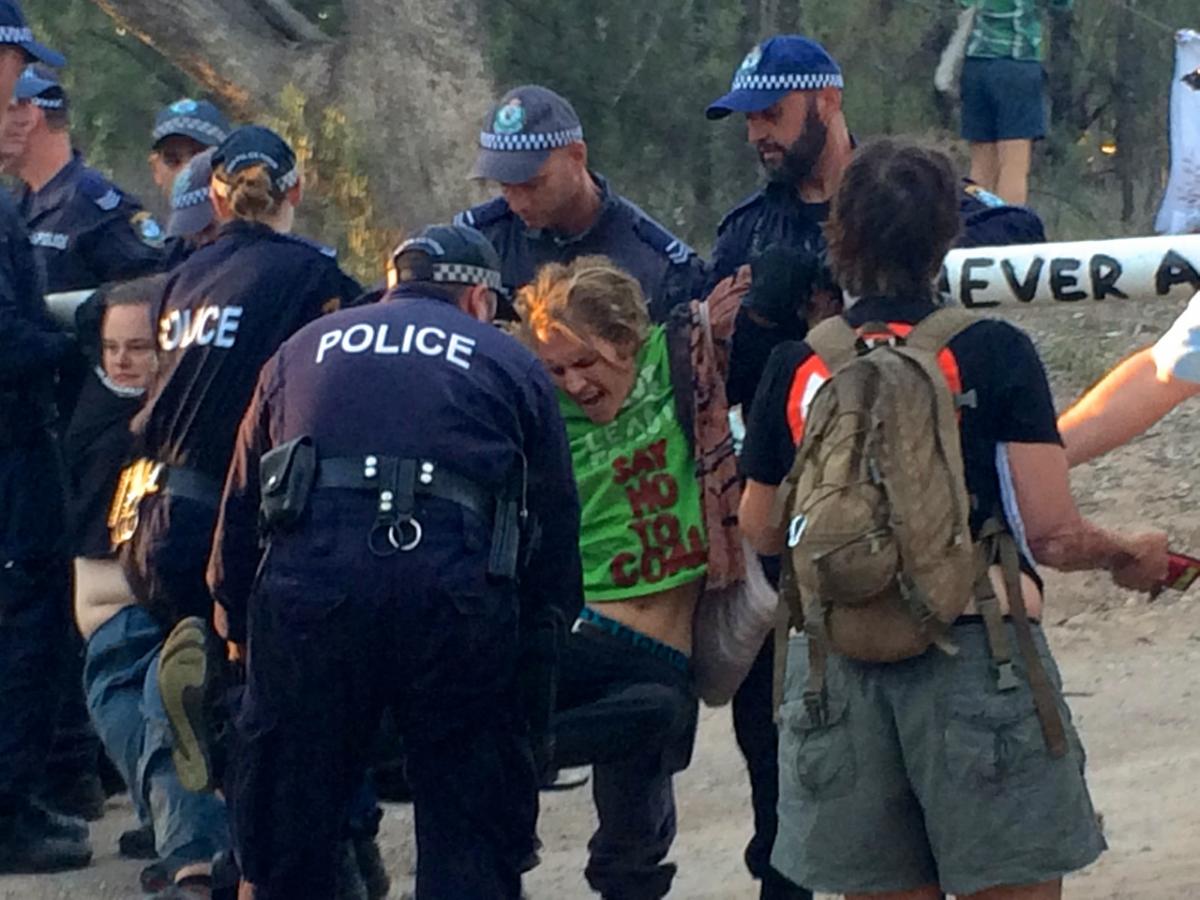At 4.30 on Wednesday morning a convoy of cars moved stealthily toward the Leard State Forest, determined to try and stop the construction of Whitehaven’s Maules Creek Mine, in north west NSW.
But the fifty-odd protestors were soon joined by sixty police, mainly from the Riot Squad, which had been sent to remove the activists blocking Whitehaven employees’ access to the mine by obstructing Leard State Forest Road.
Whitehaven Coal will (along with another nearby mine) destroy around half of the critically endangered forest. It’s a threat to the environment that today drove five of the protestors to join the more than 300 who have already been arrested fighting Whitehaven’s flagship mine.
As the protest at Leard Forest Road unfolded, another two activists hung suspended in the canopy, attempting to prevent clearing and raise awareness.
New Matilda spoke with one of the five protestors who locked their arms together with pipes, Patrick Dollard, shortly after his release from Narrabri Police Station earlier today.
“I think this campaign against coal is our generation’s Franklin River campaign,” Dollard said.
“I definitely don’t think it’s in vain, it’s helped build a lot more awareness around the coal industry.”
He said while the “over the top” police presence of roughly 45 riot police, five police rescue, ten local police, horses, quad bikes and motorbikes was intimidating, his action and the support of his fellow blockaders was empowering.
Although the police presence was very large, law enforcement allowed protesters to block the road for around three hours, and some officers even joined in as protestors sang anti-coal songs.
The atmosphere was relaxed. At one point, a protester called out “isn’t this now a police blockade? There’s more of you than us!” – one of many exchanges that drew laughter from both side.
At a de-briefing after the action, protesters even said that one officer, who’d had to inflict pain on the young protestors by dragging them off the road, still bound together by both arms, was close to tears.

The relationship with mine security was characteristically less easy, which is unsurprising, because protesters have been frustrating mine security and performing actions for over two years from their permanent blockade camp – the first to target a coal mine in Australia.
During that time protesters have cost Whitehaven Coal a considerable sum, and badly tarnished the company’s brand.
Since clearing of the Leard Forest began on Sunday protesters have devised a brand of their own, one which was painted on the pipes binding the ‘lock ons’ together – “never again”.
“The thousands of people who have visited and support this campaign, will make sure it never will happen again,” Ros Druce, a local who lives just kilometres from the mine, said.
But she, and many others, still hold out hope that Whitehaven will not be able to clear more than the portion of the forest it is currently permitted to.
“You might take our pipes but you’ll never take our forest,” she yelled, brandishing the ‘lock on’ pipe above her head, to clamorous applause after the activist who ‘locked on’ were removed from the protest.

Later, after police shut the road, and advised they would soon shut the forest, around 15 of the protestors who had not been arrested walked off into the forest, worried it will be irreconcilably damaged in the ten week period within which Whitehaven is now allowed to clear.
Most of them have been involved in a series of demonstrations earlier this week, organised by Front Line Action on Coal’s for the ‘Bat Attack’ protest festival.
Activists have joined with the Gomeroi in a candlelit vigil, a smoking ceremony, a ‘funeral procession’ down Leard State Forest Road, and an action by seven other protesters who ‘locked on’ to Whitehaven’s bulldozers as they were poised to start clearing last Sunday.
Daniel Lee, a 22-year-old environmental engineer, one of the two protesters who took to the trees to prevent clearing, said he was concerned about the 30 threatened species that will be damaged by the mine and the destruction of sacred sites.
Gomeroi elder Uncle Neville Sampson thanked the protesters at a teary smoking ceremony on Monday after the traditional custodians were forced to wear mining garb, and then denied access to their sacred sites.
“You are now our brothers and sisters,” Uncle Neville told activists after the ceremony.
Uncle Neville said that many elders had been denied the right to perform ceremony before passing away over recent months, and that he feared future generations of all descents would never see the forest, let alone its Aboriginal cultural heritage.
Dylan Sweeney, a 23-year-old studying ecology at the Sunshine Coast, has the same concern.
“I came down because I recently became an uncle,” a visibly shaken Sweeney said outside Narrabri Police Station.
“I am really concerned for what sort of world my niece is going to walk in.
“I’d like it to be one in which she has access to clean water and one in which climate change has not affected her ability to access to food, as well.”
To add insult to injury, the financial viability of Maules Creek Mine is uncertain, as New Matilda revealed last month. Whitehaven’s $79 million first-half loss, announced last month, will no doubt add to the questions being asked by analysts about the Maules Creek Mine’s bankability.
Advocates say Whitehaven has become emblematic of a dying fossil fuel industry, and the movement that is swelling in a remote NSW, near Narrabri, is leading the way for future people-driven action to address climate change and the destruction of precious ecosystems.
“Even if we were to lose this battle we can still win the next battle we face,” Patrick Dollard said.
Donate To New Matilda
New Matilda is a small, independent media outlet. We survive through reader contributions, and never losing a lawsuit. If you got something from this article, giving something back helps us to continue speaking truth to power. Every little bit counts.



